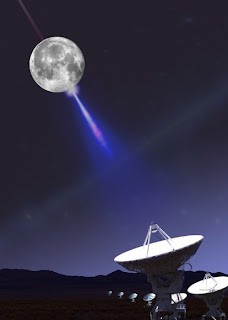Just came across this - thought it was interesting. Love the image too.
Full credit:
Radio astronomers get an assist from the Moon. Credit: Ted Jaeger, University of Iowa, NRAO/AUI/NSF
Thursday 30 December 2010
Tuesday 9 November 2010
New Comet Ikeya-Murakami
I don;t have much time right now, so here's a quick bulletin from the SPA.
NEW COMET IKEYA-MURAKAMI: Spaceweather.com Newly-discovered comet C/2010 V1 (Ikeya-Murakami) is putting on a good show for anyone with a telescope and an alarm clock. The comet is rapidly changing, and the shape of its atmosphere is similar to that of Comet Holmes after it had an outburst in 2007. Indeed, Comet Ikeya-Murakami seems likely to be experiencing a similar event. It has been in the far reaches of the Solar System for a very long time, but has been falling in towards the Sun, to which it made its closest approach (1.7 AU) in late October, so it has recently been receiving a dose of solar heating. The various automated search programmes that have taken so much of the fun (or at least success) out of old- fashioned comet-hunting in recent years, finding comets of the twentieth magnitude that nobody can see, did not discover this one. It was two Japanese amateurs, looking through their respective telescopes, who discovered it, after perihelion and already at about its present brightness; if it had been of a comparable brightness for months before, it could be expected to have been discovered sooner, although it has been approaching from behind the Sun. Ikeya was the first to see it; his name is familiar from his discovery 45 years ago of the Sun-grazing Comet Ikeya-Seki, one of the most spectacular comets of the 20th century. Amateur astronomers are encouraged to monitor developments. Various reports put the brightness of the comet between 7th and 9th magnitude, invisible to the naked eye but easy to see in telescopes and likely to be visible even binoculars. It is easy to find, in the eastern sky before dawn, a degree or so south of Saturn this morning and moving slowly south-east more or less parallel to the ecliptic, a little less than one degree a day. Bulletin compiled by Clive Down (c) 2010 the Society for Popular Astronomy The Society for Popular Astronomy has been helping beginners to amateur astronomy -- and more experienced observers -- for 50 years. If you are not a member then you may be missing something. Membership rates are extremely reasonable, starting at just £16 a year in the UK. You will receive our bright quarterly magazine Popular Astronomy, regular printed News Circulars, help and advice in pursuing your hobby, the chance to hear top astronomers at our regular meetings, and other benefits. The best news is that you can join online right now with a credit card or debit card at our lively website: http://www.popastro.com/
Monday 5 July 2010
Planck telescope reveals - the universe
Sunday 6 June 2010
New Jupiter Impact
NEW IMPACT ON JUPITER By Andrew Robertson, SPA Planetary Section Director Readers may or may not be aware of a possible new impact on Jupiter.
Amateur astronomers Anthony Wesley of Australia and Christopher Go of the Philippines have independently observed a bright flash of light on Jupiter at 20:31 UT on June 3. See http://spaceweather.com/ for a report and links to videos of the event.
The likely scenario for this is believed to be an impact but observations
made by amateurs in Western Europe as Jupiter came into view following
the event revealed no impact scar. However only low-resolution images
were possible owing to Jupiter's low altitude in a bright sky.
Any observations would be welcomed at http://popastro.com/planet/contact/
Also, if you do get a chance to look at Jupiter (which I appreciate will be difficult until Jupiter gets higher and in a darker sky) don't forget that the SEB which has almost vanished.
Saturday 6 March 2010
Cosmic Dust and Dinosaurs - from the BBC today
| Probe may have found cosmic dust Scientists may have identified the first specks of interstellar dust in material collected by the US space agency's (Nasa) Stardust spacecraft. | |
| Panel confirms dino crater link An international panel of experts has strongly endorsed the idea that an asteroid impact was responsible for killing off the dinosaurs. | |
Sunday 14 February 2010
FIREBALLS LATEST
FIREBALLS LATEST
By Alastair McBeath, SPA Meteor Section Director
French meteor analyst Karl Antier has reported to us that a magnitude
-8 or so fireball was seen from places across western and northern
France on January 24-25 at 20:51 UT. It was also caught on video, as
can be seen via the link at:http://snipurl.com/ucps2 . The fireball was
observed in the southern sky from Le Havre, so it is possible the
meteor might have been spotted, probably low to very low in the sky,
from southern England. As yet, no comparable UK reports have been
received, however.
The Co Armagh observer saw the object in the northwest to
A further fireball, seen from parts of Ireland around 19:30-19:40, was
reported as apparently fainter than the earlier meteor(s), but almost no
information other than this has reached the Section about it as yet.
For the media weblinks and further discussion, see topics on the SPA's
Observing Forum topic at:
More recently, somewhat confused reports have come through,
suggesting possibly up to three separate fireballs were seen from Ireland
and/or Northern Ireland before 20h UT on February 3-4.
Much of this news came from media reports, suggesting there were
"hundreds" of sightings, though so far, very few usable observations
have been submitted to the Section. Of those sufficiently detailed to
tell, one report each from around 17:55-18:00 UT has arrived from
Co Armagh in Northern Ireland, and a little south of Dublin's city centre
in the Irish Republic.
"hundreds" of sightings, though so far, very few usable observations
have been submitted to the Section. Of those sufficiently detailed to
tell, one report each from around 17:55-18:00 UT has arrived from
Co Armagh in Northern Ireland, and a little south of Dublin's city centre
in the Irish Republic.
The Co Armagh observer saw the object in the northwest to
north-northwest sky, while the near-Dublin observer saw the fireball
pass behind buildings to the north-northeast, at a similar elevation above
the horizon to what the Armagh witness reported for the meteor's start.
If correct, these positions show the sightings must have been of different
meteors. That might suggest there were two fireballs, one off northwest
Ireland/Northern Ireland, the other off northeast Northern Ireland/
Ireland, the neighbouring Irish Sea, or adjacent parts of western Britain,
around ~18h.
A further fireball, seen from parts of Ireland around 19:30-19:40, was
reported as apparently fainter than the earlier meteor(s), but almost no
information other than this has reached the Section about it as yet.
For the media weblinks and further discussion, see topics on the SPA's
Observing Forum topic at:
http://snipurl.com/ucsif ,and the UK Weather World's Space Weather
Forum at: http://snipurl.com/ucsim
Claims of a video recording of the ~18h fireball have proven false, as
this was imaged in 2008 apparently, and in some places online, it
seems to have been shown in reverse anyway.
Wednesday 3 February 2010
FIREBALL OVER NORTHERN BRITAIN
from the
********************************
The SOCIETY for POPULAR ASTRONOMY
********************************
=================================
Electronic News Bulletin No. 281 2010 January 31
=================================
JANUARY 16 FIREBALL OVER NORTHERN BRITAIN
By Alastair McBeath, SPA Meteor Section Director
Three observations of a bright fireball seen around 22:45 UT on January16-17 have been received, two from the Wirral peninsula (where themeteor passed almost overhead) and one from Shropshire.
Informationprovided by the lucky witnesses has suggested the object probably flew above parts of north Wales and northern England, on a roughly WSWto ENE track, and that the meteor was almost grazing the atmosphere,producing a long visible trajectory.
The start has not been well-established so far, but assuming a height of between ~120-100 km altitude suggests the fireball may have first become visible overCaernarfon Bay, about 35 km off the northern Lleyn Peninsula coastof Gwynedd, likely near 52.9°N, 5.1°W for a ~120 km altitude start,or 53°N, 4.8°W for a ~100 km start.
From there, it passed over the extreme north of mainland Wales, from roughly Caernarfon to Point ofAyr, then across the mouth of the Dee to the northern tip of the Wirral in northwest England (plausibly between West Kirby to Birkenhead),above the Mersey, Liverpool (likely a little south of the city centre) and the Pennines of the Lancs-Yorks border northeast of Manchester-Oldham, and somewhat south of Leeds, to end around 75 km altitudenear Mickletown on the River Aire, midway between Castleford andRothwell southeast of Leeds (above approximately 53.7°N, 1.4°W).
Assuming this trajectory was correct would imply the entry angle was very shallow, between ~6° to ~11° from the horizontal, giving an atmospheric path length from ~246 to ~269 km. The observers estimated the meteor was visible from 5 to 8 seconds, whose average
(~6.5 seconds) would indicate an atmospheric velocity, not allowing for deceleration, of ~38-41 km/sec, so about medium-speed on the 11 to 72 km/sec atmospheric velocity scale for meteors. The outlying range for this rough velocity would be ~31-54 km/sec. Some fragmentation along the path was seen, with the colours noted as mainly yellow or white.
The very high end height and the significant fragmentation would both count against any meteorites surviving and being recovered, while the shallow approach-angle makes it almost impossible to define where any such falls could have happened; perhaps into the eastern North Sea, the Baltic, or nearby parts of southern Scandinavia, as a best-guess. No reports of any such falls have been received as yet.
Any fresh sightings of this fireball, or others seen from the UK and nearby, would be welcomed by the Meteor Section. See the "Making and Reporting Fireball Observations" page of the SPA website, at: http://snipurl.com/u8aer, for details of what information to send, and to where.
Subscribe to:
Posts (Atom)




